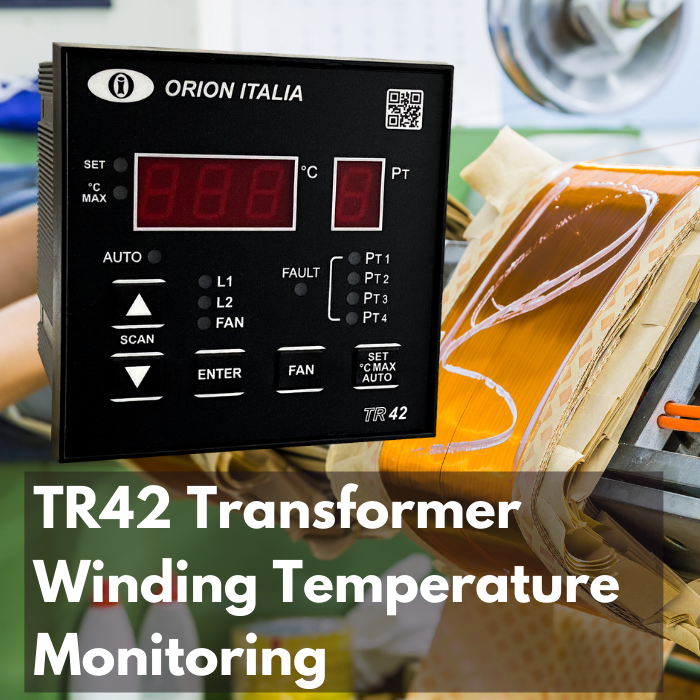Transformer Temperature Monitoring
Transformer Temperature Monitoring Device
The internal temperature of a transformer is one of the most important variables to control due to its relationship with the power and current of the transformer, our factory has supplied hundreds of thousands of transformer protection units all over the world, to learn about our relay temperature digital click on the following link:
Monitoring the temperature of transformers is crucial to ensure their proper functioning and longevity. This is especially important for transformers of the cast resin type, which are known for their high reliability and durability. If the temperature it is too high, it may indicate a fault that could damage multiple components of the transformer if left unchecked. Therefore, it is essential to measure the temperature of the transformer. Remote monitoring of the temperature is required in today's Industry 4.0 new standards.
By monitoring the temperature of transformers with our product increase stability, precision, and also efficiency can be improved, resulting in increased system life and uptime, and decreased maintenance and overall costs.
Transformer Temperature Monitoring System
To measure the temperature of a transformer it is necessary a sensor and equipment that converts the sensor signal into a value in degrees. Sometimes it is called "Transformer winding temperature sensor" to refer to the complete set, including the equipment where we can see the actual temperatures of each of winding with their wiring and sensors.
The most used sensors to measure the temperature of transformers are: RTD, Thermocouples, Pt100, Fiber optic, infrared. The use of Pt100 sensor is the most widespread for dry and cast resin transformers, due to their low cost with an exceptional accuracy, quality ratio, and good performance in a lot of environments.
Click below for more information on:
- Pt100 temperature sensor for transformer winding
- Complete solution (Pt100, Transformer temperature protection relay)
- Ready industrial box with terminals and wiring for Pt100 sensors
Transformer Winding Temperature Indicator and its calibration
This digital device has a led screen where you can see the temperature of each winding for MV / LV cast resin or dry-type transformers, in oil transformers it can be analog type sphere or other format with a scale of minimum, maximum and the actual value.
The calibration of a digital indicator is simple or non-existent once it has been verified that all the wiring and installation is correct. The temperature of the windings is measured by Pt100 probes that, being made of platinum, have known and standard resistance values for each temperature, these sensors are connected by cables to the measurement and protection relay, in this screen in addition to the actual temperatures of the windings we can see protection settings, configuration, alarms, maximum and minimum values, among other information.
Transformer Winding Temperature Range
The operating range must be that indicated by each manufacturer, in the case of dry or resin transformers, the temperature of the windings must be less than 220 °C, from there the construction material of these windings degrades.
In dry type or cast resin transformers there are 3 levels of temperature rise, this is defined on their nameplate (or data sheet), which are defined at 40 °C ambient temperature and are: 80 °C, 115 °C or 150° C, This means that the transformers can operate within that temperature range:
Example for 40 °C ambient temperature:
- Transformer with temperature rise 80 °C: it can operate* up to 120 °C
- Transformer with temperature rise 115 °C: it can operate* up to 155 °C
- Transformer with temperature rise 150 °C: it can operate* up to 190 °C
*All these operating temperature ranges are to feed power without over temperature, so as not to reduce the useful life of the transformer. The truth is that transformers accept over temperature and over load, the important thing to know is that above their allowed temperature hot spots are generated that should not exceed 220 ° C supported by the design material of the windings, and that keeping a transformer operating in extreme temperature conditions causes degradation.
Transformer Winding Temperature Calculation
The temperature in transformers is measured by sensors and thermometers, these sensors can be of the Pt100 (platinum), thermocouples, infrared, fiber optics, among others. The calculation or transformation of these signals to values in degrees centigrade (or Fahrenheit) visible on a screen is carried out by the transformer's temperature measurement, protection and control device.
The temperature in dry or cast resin transformers is usually measured by Pt100 probes directly installed in the windings, because the material of these windings is made to operate up to 220 °C, the calculation of the protection setting takes it into consideration to trip the transformer. The other meaning aspect is the manufacturing temperature rise (coefficient), for this type they are 3 levels: 80 °C, 115 °C, 150 °C (based on 40 °C of annual average ambient temperature), that is, starting from: 80 + 40 = 120 °C, 115 + 40 = 155 °C and 150 + 40 = 190 °C of temperature in the transformer windings, hot spots are generated, which must be avoided based on the calculation of the activation setting of the fans to force the air circulation and lower that temperature.
Transformer Winding Temperature Setting
They must be adjusted to temperatures that guarantee not to damage the windings, in the case of cast resin / dry transformers the windings generally degrade at 220 °C, it is also important to take into account the transformers temperature rise, which can be of 3 levels: 150 °C, 115 °C, 80 °C (these values are based on an ambient temperature of 40 °C).
Examples for an installation with an average ambient temperature of 30 °C:
- Transformer Winding Temperature Setting with a temperature rise of 150 °C: In normal conditions the transformer can operate up to 180 °C, an alarm can be set several degrees below and activate the ventilation for example 20 °C - 30 °C before reach this value and put in more ventilation power as the temperature increases, a trip setting can be activated before reaching 220 °C (this setting will depend on the type of service that the transformer is feeding, a transformer trip may mean the interruption of the power supply for all loads).
- Transformer Winding Temperature Setting with a temperatura rise of 80 °C: Up to 110 °C the transformer can operate under normal conditions, if you need to keep the transformer without overheating, you can set several degrees below the activation of forced ventilation, and set stages cooling as this temperature increases. Since the material of the windings is designed to operate below 220 °C, the tripping must be adjusted close to this value so as not to degrade the material and decrease the useful life significantly, this decision depends on the type of load is under the transformer, as tripping of the transformer may cause a power outage.
How do you measure transformer winding temperature?
The winding temperature is measured by a thermometer with any kind of sensor, generally a Pt100 platinum probe for dry and cast resin Transformers. Fiber optics, infrared sensors, or thermocouples can be used for different temperature measurements in different types of transformers.
The temperature measurement of transformer windings with platinum Pt100 probes are widely used for dry and cast resin models, the Pt100 being made from plantino, it is very easy to know the temperature in it, because for each temperature there is a resistance value (not linear), this conversion will be done by the transformer monitoring and protection relay. The following are typical resistance and temperature values for Pt100 probes:
| Temperature in °C | Pt100 (typ: 404) in Ohm |
|---|---|
| 0 | 100.00 |
| 20 | 107.79 |
| 40 | 115.54 |
| 60 | 123.24 |
| 80 | 130.89 |
| 100 | 138.50 |
| 150 | 157.31 |
| 200 | 172.84 |
| 250 | 194.07 |
How do you read a temperature gauge on a transformer?
The way to read it is by means of a digital temperature measurement equipment (used in dry, cast resin or oil transformers) or an analog thermometer (generally used in oil transformers), this digital temperature gauge has a LED display where it shows the actual winding temperature values, as well as the maximum-minimum historical values, as many other values. This transformer temperature can also be read through the communication port (RS-485 / Ethernet or other) of the measurement / control / monitoring / protection device that has the temperature sensors connected from the windings, the information can be integrated into a system Scada, PLC, information system or cloud software.










